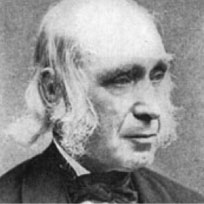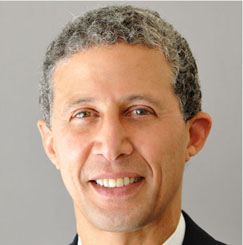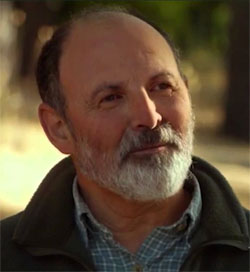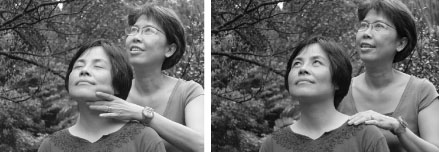Printed in the Spring 2014 issue of Quest magazine.
Citation: Alcott, A. Bronson. "An Encounter with Awe: A Dialogue with School Children" Quest 102. 2 (Spring 2014): pg. 64-66
By A. Bronson Alcott
A. Bronson Alcott (1799—1888) is chiefly remembered today as the father of Louisa May Alcott, author of the classic Little Women, which portrays the life of their family at the time of the Civil War.
Alcott himself, however, was a noted figure in the New England Transcendentalist movement and was friends with such luminaries as Ralph Waldo Emerson. Alcott was also an innovative educator. His most famous educational experiment was the Temple School, which he started in Boston in 1834. His assistants included Margaret Fuller, later known as a champion of women's rights.
Alcott's method of teaching included dialogues with children on spiritual subjects. These dialogues were recorded by his assistant Margaret Peabody and published in two volumes in 1836—37 under the title Conversations with Children on the Gospels. The book drew intense criticism because of its freethinking approach to Scripture, which some Bostonians regarded as blasphemous. The resulting outcry led many parents to withdraw their children from the school, and Alcott was forced to close it in 1837. He was forced to close another school later on for admitting a black child and refusing to expel him despite heavy pressure.
Always improvident, Alcott never attained financial security until his daughter became a best-selling author, but his teaching methods were innovative and inspiring. Below is the record of one conversation. —Ed.
 Mr. Alcott: Jesus was at Cana the last time we read of him and received a visit from a nobleman of Capernaum. Today we find him at Nazareth. (Reading:)
Mr. Alcott: Jesus was at Cana the last time we read of him and received a visit from a nobleman of Capernaum. Today we find him at Nazareth. (Reading:)
And he came to Nazareth, where he had been brought up: and, as his custom was, he went into the synagogue on the sabbath day, and stood up for to read. And there was delivered unto him the book of the prophet Esaias. And when he had opened the book, he found the place where it was written, the Spirit of the Lord is upon me, because he hath anointed me to preach the Gospel to the poor. He hath sent me to heal the brokenhearted, to preach deliverance to the captives, and recovering of sight to the blind, to set at liberty them that are bruised, to preach the acceptable year of the Lord. And he closed the book, and he gave it again to the minister, and sat down. And the eyes of all them that were in the synagogue were fastened on him. And he began to say unto them, This day is this scripture fulfilled in your ears.
And all bare him witness, and wondered at the gracious words which proceeded out of his mouth. And they said, Is not this Joseph's son? And he said unto them, Ye will surely say unto me this proverb, Physician, heal thyself: whatsoever we have heard done in Capernaum, do also here in thy country. And he said, Verily I say unto you, No prophet is accepted in his own country. But I tell you of a truth, many widows were in Israel in the days of Elias, when the heaven was shut up three years and six months, when great famine was throughout all the land; but unto none of them was Elias sent, save unto Sarepta, a city of Sidon, unto a woman that was a widow. And many lepers were in Israel in the time of Eliseus the prophet; and none of them was cleansed, saving Naaman the Syrian. And all they in the synagogue, when they heard these things, were filled with wrath, and rose up, and thrust him out of the city, and led him unto the brow of the hill whereon their city was built, that they might cast him down headlong. But he passing through the midst of them went his way. (Luke 4:16-30)
Emma: I think there was something miraculous in the escape of Jesus.
Ellen: He would not have escaped if he had deserved to be cast down.
Mr. Alcott: What preserved him?
Ellen: The spirit that was in him; they were awed by his looks.
John B.: God was in him.
Augustine: He did not escape because he deserved to. He deserved not to be crucified.
Ellen: He escaped then, because it could not have done good to others to have him killed then, as it did when he was crucified.
Mr. Alcott: What was that in him which produced the awe of which Ellen spoke?
Several (at once): Conscience. Truth. Indignation.
Charles: The supernatural.
Franklin: I think it was because they saw him go along without the least fear. This surprised them so, that they were motionless, until he was gone, and I think they were all left standing in amazement.
Andrew: As he did not seem afraid of them, they thought it would be of no use to throw him down the hill. They feared he would do something to them.
Samuel R.: His not being afraid made them afraid.
Charles: It seemed to me that they carried him to the very verge before he looked at them. Then, I thought, he turned and looked, and they were so struck that they stood motionless, with their hands up all ready to strike.
George K. I think their hands fell when Jesus turned upon them.
Mr. Alcott: Did you ever have any person look at you as if they saw everything in you? (Several held up hands.) What if you should try this method of "looking"when you are struck or injured by boys in the street?
Charles: Suppose a look does not do?
Mr. Alcott: It will be time then to try some other means. Try this first. Can you tell when you have seen a similar effect produced?
Charles: Yes, I have seen it among boys. When some boys were once abusing a little boy, they stopped short as I saw them; there seemed no reason but his looking at them. And once I was going to drown a puppy, and he looked up at me so that I could not.
Emma: Once you looked at me when I was whispering, and I could not look at you.
John B: I have felt that when I was playing in school, very often.
Samuel R.: I once wanted a dog to do something; he did not want to; and I was going to beat him, and he looked at me so that I could not.
Mr. Alcott: There is a creature—very feeble—who lives in your house, but in whose feebleness there is a power —
Several. Little babies.
Mr. Alcott: Have any of you ever been awed by a child's face?
Herbert: I have.
Lucy: So have I. I have tried to take a baby, and it did not want to be taken, and I did not want to, then.
Mr. Alcott: Did any of you ever take a little baby, and swing and toss it round, without observing how it looked, or feeling any awe? How many take away things from children, without caring how they feel or look?
Samuel R.: Yes; sometimes I have wanted to take away something from my little sister, and could not, because she looked so innocent.
Mr. Alcott: How many think there is something supernatural in a babe? (Several held up hands.) How many of you think there was a good deal of this look in Jesus, that helped him escape? (Many held up hands.) Was that a miracle?
Emma: Yes.
Ellen: I do not think it was a miracle. It was natural that he should look so, and that they should feel it.
Mr. Alcott: Is a miracle unnatural?
Ellen: It has not a natural cause.
Mr. Alcott: Could there be anything natural without the supernatural? "Supernatural"means "above nature,"and does not the power above nature show itself in nature, and cause those acts which you call miraculous?
(No answer.)
John B.: I liked the passage that Jesus read. "Preaching the gospel to the poor"means that he would teach them how to get their living. "Healing the brokenhearted"means to comfort them when their brothers and sisters die. I don't understand about "preaching deliverance.""Recovering sight to the blind"means curing spiritual blindness, and curing outward eyes too, so that the outward eyes may see the emblems of spiritual things. I don't understand the rest.
George K.: I think "the Spirit of the Lord"is God. "The poor"means poor in money, and the preaching is to make them good and go to meeting. To "preach deliverance to captives"is to preach in prisons, that if they would repent God would not punish them. To "recover sight to the blind"is to clear out the Spirit's eye as well as the body's. To "bind up the bruised"is to heal them.
Martha: I think to "preach to the poor"is to preach to the poor in spirit, to those who have not goodness in their spirit; and to "heal the brokenhearted"is to comfort the sorrowing for friends.
Mr. Alcott: What else causes sorrow but loss of friends?
Franklin: The wickedness of our friends.
Charles: Those would be comforted by explaining the uses of the punishments.
Mr. Alcott: Would you like the world better if there was no punishment and no suffering?
Several: Once I thought so.
Mr. Alcott: Do you see any good in suffering or in punishment now? Who makes you suffer?
Charles: Ourselves.
Lucy: The "Spirit's anointing him"means that God had made him good, to make those who were poor in goodness, rich.
Mr. Alcott: Then there is another kind of poverty than of riches. Which is the worst kind of poverty?
Lucy: Poverty of kindness.
Mr. Alcott: Do you suppose there are any very poor people, who are rich in spirit?
Lucy: Yes; the brokenhearted means being sorry for wrongdoing, and he gives them repentance to bind them up. The captives means those who are bound by their wickedness.
Mr. Alcott: Give me an instance of such a captive.
Lucy: A little girl who has done wrong and is not sorry is "captivated"by her sin, and being blind means that they cannot see goodness.
Mr. Alcott: Did they lose their sight all at once?
Lucy: No, not all at once; but they do wickedly, and then forget the difference between right and wrong.
Mr. Alcott: Do we begin by knowing right and wrong?
Lucy: Yes.
Mr. Alcott: Have you lost any of your spiritual sight?
Lucy: I suppose I have since I was a baby.
Welles and Nathan: I did not know anything when I was a baby. There is no right or wrong in a baby.
Lucy: "The bruised"means those who are a little wicked, but want to be good, and Jesus will show them how.
Mr. Alcott: Was the Spirit of the Lord ever upon you?
John B.: When I have been doing right it has helped me, and when I have been helping others.
Mr. Alcott: Do you ever deliver the captive—those captured by bad habits—even yourselves? (None.) Are any of you blind? (Several.) Do you begin to recover sight? (All held up hands.) How many spend all the year acceptably to the Lord? (None.)
Ellen: I want to know what Josiah thinks.
Josiah: I have no thoughts.
Mr. Alcott: Suppose a person is greater, better than people around him; how will they treat him?
Augustine: He must make them understand him.
Mr. Alcott: Suppose they are interested in other things?
Augustine: He must talk to them and convince them, not all at once, nor everyone. Those people thought a carpenter was not so high as others. But there is no reason why a carpenter's son should not be as great as any other man.
Lemuel: Because they are poor! Some people think their riches include goodness.
Mr. Alcott: How many of you think that if you were to go into another town or school and begin to talk as you do here on spiritual subjects, you should be understood; or would it be disagreeable?
Lemuel: The schoolmaster would not let you stay.
George K.: He would be glad, if he was a spiritual man, for then he would teach so himself. But I guess he would not be a spiritual man if he did not have spiritual scholars.
Mr. Alcott: Most schoolmasters mean to be spiritual.
Lemuel: I know one who is not spiritual.
From A. Bronson Alcott, How Like an Angel Came I Down: Conversations with Children on the Gospels, recorded by Elizabeth Peabody and edited by Alice O. Howell. Originally published 1836—37; reprinted 1991 by Lindisfarne Books. Reprinted with permission of Lindisfarne Books.


 Every year I return to my old hometown of New York to spend Thanksgiving with my family. A couple of years ago Lyn Trotman, one of our Eastern regional directors and president of the New York branch, suggested that since I would be in town anyway, I should stop by and speak at the lodge. This was a no-brainer for me. We had a full house and a wonderful social time with good food and good conversation following the talk. During our social time I was informed by members of the lodge's board of directors that I would be scheduled to speak each year on the Saturday following Thanksgiving. It is possible that I could have had some say in the matter, but I think they knew me too well.
Every year I return to my old hometown of New York to spend Thanksgiving with my family. A couple of years ago Lyn Trotman, one of our Eastern regional directors and president of the New York branch, suggested that since I would be in town anyway, I should stop by and speak at the lodge. This was a no-brainer for me. We had a full house and a wonderful social time with good food and good conversation following the talk. During our social time I was informed by members of the lodge's board of directors that I would be scheduled to speak each year on the Saturday following Thanksgiving. It is possible that I could have had some say in the matter, but I think they knew me too well. Profound moments in nature foster a true and vital understanding of our place in the world. I remember an experience I had as a five-year-old boy that awakened in me a lifelong fascination for marshes and birds, and for a life lived wild and free.
Profound moments in nature foster a true and vital understanding of our place in the world. I remember an experience I had as a five-year-old boy that awakened in me a lifelong fascination for marshes and birds, and for a life lived wild and free.
 Mr. Alcott: Jesus was at Cana the last time we read of him and received a visit from a nobleman of Capernaum. Today we find him at Nazareth. (Reading:)
Mr. Alcott: Jesus was at Cana the last time we read of him and received a visit from a nobleman of Capernaum. Today we find him at Nazareth. (Reading:)